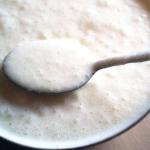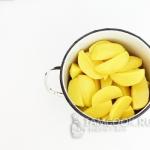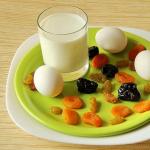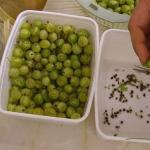Easter wreaths with candied fruits. Easter wreaths Easter wreath not with sweet filling
: A closed circle symbolizes eternity. Baking an Easter wreath or its variety - a product shaped like an Easter flower - is traditional, along with the preparation of tall Easter cakes with a white “hat”, Easter cottage cheese and colored eggs.
For the bright holiday of Easter, traditionally, every housewife tries to prepare many festive dishes, including fragrant Easter cakes and pies, colored eggs, meat delicacies and much more. And since Easter is one of the main Christian holidays, they prepare for it in advance, thinking through treats for a noble feast. You want to serve dishes to the festive table not only tasty, but also beautiful.
It will be a wonderful decoration for a festive meal. At the same time, a distinctive feature of the Easter wreath is the placement of a festive symbol in it - colored eggs. A product is prepared from yeast dough. It is divided into strands, woven like a braid and secured in the form of a ring-wreath.
This unusually shaped butter pie is decorated with confectionery sprinkles, icing, and nuts, berries and dried fruits are added to the dough. When placing the cake on the table, it is beautifully decorated using multi-colored ribbons, flowers, and candles. You can also place colored eggs and a small Easter cake in the hole.
Small wreaths can be used as edible egg cups. If you put grass in the middle of such a wreath and plant a small hen or chick, you will get a cute one.
Traditional Easter wreath recipe
The Easter wreath is a symbol of rebirth. The recipe for its preparation is quite simple, but requires special attention. It is believed that Easter cakes and other baked goods absorb the energy of the person who cooks. Therefore, it is necessary to prepare a wreath with bright thoughts and prayer.
To prepare the simplest version of this symbolic Easter table decoration you will need:
- 500 g flour;
- a pack of dry yeast;
- 50 g granulated sugar;
- 250 g milk;
- 1 egg and 1 egg yolk;
- 75 g sl. oils;
- 80 g raisins.
Knead a soft dough from flour, milk, yeast, eggs, sugar and butter, add raisins to it and leave for 50-60 minutes in a warm place to rise. As soon as the dough rises, knead it again and divide it into 4 parts. Roll each piece of dough into a rope.
Weave a braid from three strands and wrap it in a wreath. Wrap the fourth strand around the wreath in a circle. Coat the product with egg yolk, place on a greased baking sheet and leave for 15–20 minutes to proof. Place the wreath in the oven, preheated to 200 degrees, and bake for 40 minutes.
Place the finished wreath on a dish, place sprouted watercress or wheat, flowers inside, and place dyes.
Easter flower with nuts and candied fruits
An Easter wreath can also be made in the form of an elegant flower, because Easter is a celebration of the rebirth of life. This flower is otherwise called the “Easter flower”, or “Easter nest”, because this sweet product is very similar to a nest with brightly colored eggs inside. However, you should not bake an Easter wreath from the many available options for Easter cake dough: the recipe for its preparation is classic, using yeast.
For this test you will need:
- 50 g yeast;
- 0.5 tbsp. milk;
- 3 eggs;
- 75 g granulated sugar;
- 100 g sl. oils;
- 1/4 tbsp. rast. oils;
- salt to taste;
- 450 g flour.
For the filling you will need the following ingredients.
And to prepare the glaze, use 100 g of powdered sugar and 2 tbsp. l. lemon juice. The product is baked from rich yeast dough. To prepare it, grind the yeast with 1-2 tbsp. l. granulated sugar and dilute with warm milk. Add a little flour and stir to form a loose dough. Leave the resulting dough in a warm place for 15 minutes, covering it with a napkin.
When the dough is ready, add warm butter, eggs beaten with sugar, salt and gradually add flour. When the dough stops sticking to your hands, add vegetable oil along with the last portion of flour. Place the kneaded dough in a bowl and leave for another 20-25 minutes. in a warm place.
Then you need to carefully knead the dough again and roll it into a rectangle. Grease it with butter, sprinkle with sugar, poppy seeds, raisins and candied fruits. Roll the rectangle into a roll. Place the roll on greased parchment and roll it into a ring. To prevent the joint from being noticeable, you can cover it with a decoration made from leftover dough.
Using scissors or a knife, make external cuts along the entire circumference and transfer the flower along with the paper to a baking sheet, where it should stand for 15 minutes before planting in the oven. The flower is baked at a temperature of 180 degrees for 30–35 minutes. In 10 min. Brush the product with beaten egg until the end of baking. We take out the finished flower, sprinkle it with water and cover it with a napkin.
To prepare the glaze, mix powdered sugar with lemon juice to the consistency of thick sour cream and pour the mixture over the cooled baked goods. When the glaze has set a little, you can start decorating. For this you can use sprinkles, candied fruits, marmalade, nuts, etc.
Place the finished product on a dish, fill with painted eggs, pysanky, sugar or baked chicken. You can serve it to the Easter table.
This pastry can become a real decoration for the Easter table. In the middle of the Easter wreath, you can arrange the eggs, like in a basket, and decorate the wreath itself with different flowers from sugar mastic. The advantages of the Easter wreath also include excellent taste, light airy dough and a variety of fillings. Both adults and children will enjoy this treat.
If you have never tried baking with yeast dough, then this recipe will also suit you. We tried to make it as detailed as possible. Give it a try.
To prepare the Easter wreath you will need:

- 7 g dry yeast for dough (or 30 g raw)
- 600-800 g flour
- 250 ml milk
- 3 eggs
- 300 g sugar
- 100 g butter
- 2 tsp vanilla sugar
- 150-200 g dried apricots
- 150-200 g prunes
- 150-200 g raisins
For sugar mastic:
- 1-2 cups powdered sugar
- ¾ cup milk powder
- 0.5 cups potato starch
- ¾ cup condensed milk
- 3-4 tbsp. spoons of lemon juice
Mastic can be replaced with a traditional icing for this holiday, made from egg whites beaten with sugar.
Warm the milk a little. It should be warm, but not hot.

Add dry yeast to the milk for the dough.

Gradually add half the flour to make a pancake-like dough. It is recommended to sift the flour immediately before adding it to the dough to remove lumps and possible debris and make it more airy.

Mix well and put in a warm place. This could be a slightly heated oven that is turned off, a cup of hot water that will need to be changed periodically, or a place next to a radiator. In the latter case, the pan must be turned the other way from time to time.

The dough should approximately double in size or even begin to sag a little. This may take about an hour, depending on the temperature in which.

Separate the yolks from the whites. Beat the yolks with sugar, add vanilla sugar.

Beat the whites separately with a pinch of salt until a thick foam forms.

Knead the butter thoroughly (do not melt!).
When the dough is ready, add the beaten yolks to it and mix.

Add softened butter and mix.

Add whipped whites.
Mix thoroughly.

Now gradually add the remaining flour and begin to knead the dough.

A well-kneaded dough should not stick to your hands by the end of this process. If it sticks, add a little flour.

Now the pan needs to be put back in a warm place and covered with a towel or lid. We select the pan taking into account the fact that the dough will at least double in size.
The rising time of the dough depends on the quality of the ingredients and the temperature at which it stands. Usually it is 1-2 hours.

When the dough has risen, we briefly knead it with our hands again and leave it to rise a second time.

Preparing the filling:
You can experiment with fillings, add different nuts, fruits, candied fruits. I chose raisins, dried apricots and prunes. All this must first be washed and dried.

Cut dried apricots and prunes into small pieces.

Forming an Easter wreath:
We wait until the dough rises a second time.

Divide the dough into three equal parts.

Roll each part into a strip measuring about 10x50 cm.

Place filling on each strip. The thicker the layer of filling, the more difficult it is to form the wreath (and this may negatively affect its appearance), but the tastier the baked goods will be.

Roll each strip into a roll.

And securely fasten the edges.

From three rolls you need to form a pigtail, as in the photo, or simply twist it with a rope, as is more convenient for you.

Then we connect the edges into a ring and place it on a baking sheet, previously covered with baking paper or greased with oil. Keep in mind that the dough will double in size.

Place a fireproof mold in the middle of the wreath (this is done to create a depression in which you can then put the eggs).
Bake in an oven preheated to 180° for 35-40 minutes. When the Easter wreath is baked, you need to let it cool, covered with a towel. Serve by placing the eggs in the well.


The Easter wreath can also be decorated with glaze made from egg whites beaten with sugar or covered with sugar mastic.
Preparation of sugar mastic
The good thing about this recipe is that it is suitable even for beginners.
In a cup, mix dry milk (¾ cup), powdered sugar (¾ cup) and condensed milk (¾ cup).

Mix thoroughly until smooth, add lemon juice (1 tablespoon) and mix again.

Cover the table with powdered sugar, place the resulting mass on it and knead with your hands, gradually adding powdered sugar. When the mastic stops sticking to your hands, you can add a little potato starch. The mastic should be elastic, but at the same time soft, like plasticine. If it is hard, then add a little more lemon juice; if it is not elastic enough, then you can add powdered sugar or potato starch.

The color of the mastic is beige, close to white. This way you can cover the entire Easter wreath. A large sheet can be rolled out on a table sprinkled with powder or starch, or between plastic bags greased with sunflower oil. The sheet should not be too thin; a thickness of three to four millimeters is quite enough.

I like the second method better, since it is easier to take the rolled out sheet from the table so that it does not tear, and it is easy to cover and smooth the wreath.
To get colored mastic, add food coloring to it. You can, for example, color it with cocoa, beetroot or carrot juice.
To form flowers from sugar mastic, figurines, it would be nice to have convenient tools, for example

You can make leaves or roses from small pieces of colored mastic. It all depends on your fantasies and desires.

If you were covering the cake and the mastic was a little torn, you can cover the area with an additional piece of mastic, smoothing it with a soft wet brush.
You can store the finished mastic for several days or even a week if it is sealed tightly.
Mastic is very sensitive to moisture, so you should not store baked goods decorated with it in a room with high humidity.
If you want the mastic to shine, cover it with a mixture of honey and vodka (1/1) using a soft brush. The vodka will evaporate very quickly, and the honey will remain shiny on the mastic.
So the main decoration of the Easter table is ready. Happy Easter to you!
Recipe for making an Easter wreath and bunnies from yeast dough. In order to decorate the Easter table, you can prepare an interesting pastry - an airy wreath with a triple filling of dried fruits (in our case, dried apricots, dates and raisins), as well as Easter bunnies. The younger members of the family are always satisfied with such baked goods. Moreover, the filling for the wreath can be varied - nuts, dried fruits, candied fruits or dried berries. The dough is prepared with yeast based on milk, eggs and butter. You can decorate baked goods in different ways, but the simplest is to sprinkle them with decorative decorations for Easter cakes.
Compound:
200 ml. warm milk (1 glass);
60 – 70 g butter;
4 tbsp. spoons of sugar;
1 teaspoon salt;
1 teaspoon dry yeast;
3 eggs (2 for the dough + 1 for greasing);
550 – 600 g flour;
80 g dried apricots;
80 g raisins;
80 g dates (pitted);
2 tbsp. spoons of sugar water (for greasing);
Decorative decoration for Easter cakes.
How to cook:
Heat the milk a little in the microwave in advance and melt the butter. Knead the dough in a large bowl. Mix together: warm milk, melted butter, sugar, salt, eggs and yeast. Leave the dough in a warm place until the yeast becomes active and a characteristic foam appears on the surface.
Then start adding flour into the dough in small portions. Do not add all the flour at once, as during kneading your dough may take a little more or less flour. The finished dough should not be oversaturated with flour, it should be elastic and easily stick to your hands.

Cover the dough with cling film or a damp towel and leave to rise in a warm place for one hour. I traditionally leave the dough in a slightly warm oven.

While the dough is rising, prepare the dried fruit for the filling. I have dried apricots, raisins and dates on hand - you can take what you have (dried fruits, nuts, candied fruits). Rinse dried fruits in warm water and dry with paper towels. Chop the dried apricots into small pieces with a knife. Just leave the raisins whole, and separate the dates from the stone and chop them finely.

Place the risen dough on a floured surface and knead lightly. Divide into two unequal parts.

Cover the smaller one with cellophane and set aside. Divide the larger part into three more equal parts - these will be the rolls for the wreath. Take one ball and roll it into a long sausage (about 50 cm). Using a rolling pin, roll out into a wide strip (about 7 - 10 cm). Place the filling, such as dried apricots, in the center.

Then roll it up and pinch the seam tightly.

In this way, collect all three rolls. You should end up with three long rolls with different fillings.

Weave these rolls into a tight braid and pinch the edges tightly with your hands. Curl the braid into a wreath, leaving some space in the middle.

Prepare a convenient baking dish and grease it with butter (butter, vegetable). You can prepare a regular baking sheet lined with parchment for baking. Carefully transfer the wreath into the mold, cover with cellophane and put in a warm place for another 20 - 30 minutes to proof.

Meanwhile, work on the reserved portion of the dough.
You can use it to form small Easter bunnies (cranes). To prepare such buns you need to collect very dense balls of dough, without air bubbles. You can assemble the balls in different ways, whatever is more convenient for you, the main thing is that as a result you get round and very dense dough pieces.

Place the prepared balls on a small baking sheet lined with parchment. Cover the dough with cellophane and place in a warm place for 20 minutes.

Preheat the oven to 180 degrees in advance.
Meanwhile, the wreath has already steeped and needs to be greased with beaten egg.

Place the wreath in the preheated oven for 20 minutes and bake until golden brown.

While the Easter wreath is baking, prepare the bunnies for baking. Using scissors, cut out the ears and tighten them a little, and use a stick to squeeze out the eyes on the muzzle. Using your fingers, press down on the sides of the ball to visually separate the head from the body. Brush the bunnies with the remaining beaten egg. The buns are baked in the same way, at 180 degrees for 15 - 20 minutes.

Grease the finished hot pastries with a sugar solution and decorate with a decorative decoration for Easter cakes. Easter wreath and bunnies are ready!

Holy Easter is approaching, which means that soon our table will once again be filled with a huge variety. Thus, many have a tradition of preparing an Easter wreath from yeast dough. Easter eggs are placed in the center of such a wreath, of course, if you make a larger hole in advance. The picture turns out to be more than festive. There are a huge variety of types and methods of preparing this pastry, but I will tell you about the “pigtail wreath”, each weave of which has its own filling, different from the previous one. And we will complement all this beauty with lemon impregnation, which, spreading over the top layer, will get into the most hidden corners and thereby make our baked goods very tender and juicy. So, let's get acquainted with baking and start cooking.
Ingredients:
- milk – 250 ml;
- granulated sugar – 2 tablespoons (to taste);
- chicken egg - 1 piece;
- dry yeast – 10 grams;
- vegetable oil – 2-3 tablespoons;
- wheat flour – 500 grams (100 grams);
- salt - a pinch;
- filling – to choose from (3 types);
- butter - for greasing;
- lemon – 1 piece;
- powdered sugar – 50 grams.
- total cooking time: 2 hours.
How to make an Easter wreath from yeast dough:
1. Prepare the dough. In general, keep in mind that any Easter baked goods must be prepared using the sponge method. But this method of preparing yeast dough will be very fast: warm milk, granulated sugar, salt and a little flour - mix it all until smooth. Afterwards, add dry yeast to the main ingredients. About 10 minutes after you leave the dough in a calm state, a yeast cap will form above it, which you can see in the photo.

2. The next step is to add chicken eggs, vegetable oil and wheat flour to the dough. After adding each ingredient, stir the contents of the bowl. I indicated a larger amount of flour because you will also need it to dust your work surface, so don't use it all at once. As soon as the dough becomes tender, but no longer sticks to your hands, the dough is ready.

3. You can leave the dough for 1 hour, in a warm and dark place. But within half an hour it had risen greatly - to speed up the process, I placed a large bowl of warm water underneath.

4. This kind of dough was waiting for me, after the specified time.

5. I divided the finished yeast dough into three equal parts, rolled each of them out, and laid out the filling in the center. In the first case. It was jam with starch (which will prevent the jam from leaking, please note, using a liquid filling).
6. In the second case it was chocolate.
7. In the third case, the filling was poppy seed.

8. As soon as the filling was in place, we closed each of the layers, pinching the edges. Then, remembering our childhood skills, we wove them into a braid, the ends of which were connected to the beginning, thereby forming something like a wreath.
This creation went into a preheated oven for 35 minutes at 200 degrees. I baked the bottom first (about 15 minutes until golden brown), then the top for 20 minutes.

9. Grease the finished Easter wreath with a small amount of butter (which is optional, but desirable).
10. Squeeze lemon juice into powdered sugar and mix. You can even beat it to make it whiter. We water the Easter wreath with the finished mixture. Then, let the baked goods soak and after cooling, serve it to the table. Do not forget that when cutting hot yeast baked goods, you will encounter not only difficulties, but also an unattractive appearance.
Bon appetit!!!
Best regards, Yulia.
The day after tomorrow is Easter and I’m back with a new recipe. Appetizing, rosy, fragrant and very tasty Easter wreaths with multi-colored candied fruits are a delicious holiday pastry. Just look how elegant they are: you can not only treat your family with braids, but also give them to friends and family!
I have described today’s step-by-step Easter baking recipe in more detail, so most likely there will be no additional questions when preparing the wreaths. I will touch upon only one point, which concerns the filler and flavorings. Instead of candied fruits, you can use the same amount of raisins, dried apricots, prunes, dried cherries, cranberries, nuts of your choice. Orange or lemon zest, spices, or industrial or homemade liquid flavorings will help you make the dough even more aromatic.
In total, from the specified amount of ingredients used, 12 fairly large butter wreaths are obtained. If you want, you can reduce the proportions by half - then there will be 6 products. The finished baked goods will delight you with a crispy crust and a dense, elastic (like fresh lamb), but at the same time tender crumb. We store Easter wreaths in an airtight container or plastic bag.
Ingredients:
Yeast dough:
(520 grams) (150 milliliters) (100 grams) (80 grams) (2 pieces ) (7 grams) (0.5 teaspoon) (1 pinch)
Filling and lubrication:
Cooking the dish step by step with photos:


Sift (preferably twice) premium wheat flour into a bowl (I put the whole amount at once). Due to this, the flour will not only loosen and be saturated with oxygen, but also possible debris will be removed. You may need a little less or more flour - it depends on its quality (in particular moisture content). That is why I would advise you not to use all the flour at once, but to start with 450-480 grams - then you will be guided by the consistency of the dough.


Mix everything thoroughly with a fork or whisk. About yeast: it is not necessary to take exactly fast-acting yeast - just dry (also 7 grams) or pressed yeast (you need 3 times more, that is, 21 grams) will work perfectly. Such yeast is not immediately mixed with flour, but is pre-activated in a warm, sweetish liquid for 10-15 minutes. In our case, you can slightly heat 150 milliliters of milk with a tablespoon of sugar and dissolve the yeast in it. Make a well in the flour and pour lukewarm milk into it, break 2 chicken eggs.

First, you can stir the ingredients with a spoon or fork to moisten the flour by absorbing the liquid. If you want, you can immediately knead the dough with your hands. If you have a dough mixer or bread machine, be sure to use their help - it’s easier and faster. Add 100 grams of very soft butter to the flour lumps, which we take out of the refrigerator a few hours before and leave to warm up on the table. You do not need to add the oil all at once, but gradually - each new portion, when the previous one is mixed into the dough.

You need to knead the dough for Easter wreaths for quite a long time (at least 10, preferably 15 minutes) and intensively. As a result, it will become smooth, uniform, quite dense and elastic. This is exactly the consistency we need, since the soft and too tender dough will make wreaths, but they will not be embossed. Form the dough into a ball and place it in a bowl. We put it in a warm place for 1 hour, after which we do a light kneading, re-rounding and again in a warm place for another 1 hour (steps 9-11). Where is the best place for the dough to ferment and what does a warm place mean? There are several options. First of all, in the oven with the light on (it turns out to be approximately 28-30 degrees - the ideal temperature for fermenting yeast dough). Then cover the bowl with the dough with cling film or cover it with a towel made of natural fabric (linen is best) so that the surface does not become airy and crusty. You can also let the dough ferment in the microwave, in which you first bring a glass of water to a boil. The dough will rise when the door is closed, and the glass will stand there. Then there is no need to cover the bowl with anything, since the water will evaporate, thereby maintaining the necessary humidity. Just make sure that no one accidentally turns on the microwave, otherwise the dough will be lost and there will be no Easter wreaths.

While the dough is fermenting, you can go about your business and prepare our bright, tasty, sweet filling. Cut multi-colored candied fruits (I used pineapple) into cubes as small as possible.

Since I decided to make 12 Easter wreaths, I immediately weighed the chopped candied fruits on a kitchen scale and laid them out in piles - this saves time, and accuracy never hurts. In total there were 12 slides of candied fruits, each 20 grams.

After about 1 hour (time is a relative concept, you may need more or less), the yeast dough for Easter baking will rise very well, increasing in volume exactly three times. It is very airy and fluffy. If the dough rises poorly, it means you have old yeast - increase the fermentation time.



We knead it and divide it into 2 equal parts - each approximately 478 grams. We round each piece and roll it into a ball. Next we will work with one part of the dough, so we transfer the second bun into a new plastic bag, release the air and tie it tightly, leaving some space inside. We put the dough in the refrigerator - there it will wait in the wings while we work on the second piece.

We divide the bun that remains on the table into 6 parts of the same size - each weighs 80 grams (+/-1-2 grams). Why is it so important that the workpieces are the same in weight? First of all, they will need the same amount of time for both proofing and baking. Well, the aesthetic side is also important - the finished Easter wreaths will all be as if they were chosen.

An important step when preparing yeast baked goods is rounding the dough. Since the dough for this recipe does not stick to your hands at all, there is no need to additionally dust the work surface with wheat flour. Take one piece of dough and beat it into a flat cake with your palm several times to remove excess air. If you have little experience in working with yeast dough and forming the pieces takes a lot of time, cover the remaining pieces of dough with cling film to prevent them from becoming airy and crusty.



Turn the ball of dough over, seam side down, and round the future buns. It’s quite difficult for me to show the process without a video, but I’ll try to describe it. We squeeze our working palm, spreading our fingers, as if holding a large orange. Cover the workpiece with your palm in this position and begin to rotate the dough ball counterclockwise. Everything happens easily and effortlessly, while we kind of bend the dough inward a little with 4 fingers, but without pressing.

In this way we will roll up all 6 blanks for future Easter wreaths. They turn out neat and smooth.

Since we tortured the dough, it needs to be given time to recover and relax - cover the buns with cling film and leave them directly on the table for 10-15 minutes. If you don’t give the pieces a rest, the dough will resist when rolling: you roll it out with a rolling pin, but it slides back.

When the cones have rested and even swollen slightly, we move on to the next stage. Using a rolling pin, roll out one ball of yeast dough into a square as thin as possible - ideally no more than 2 millimeters thick.










